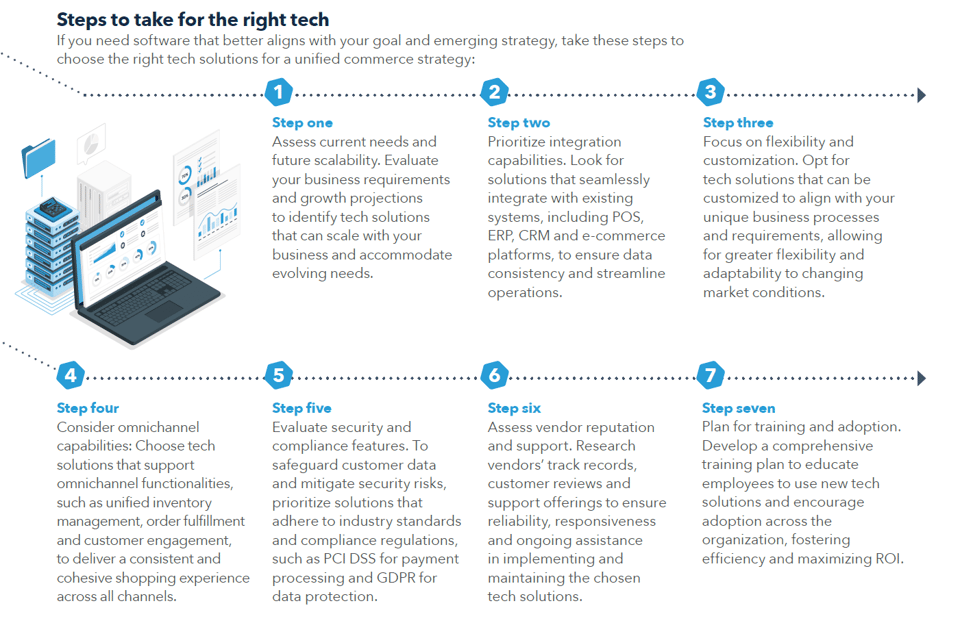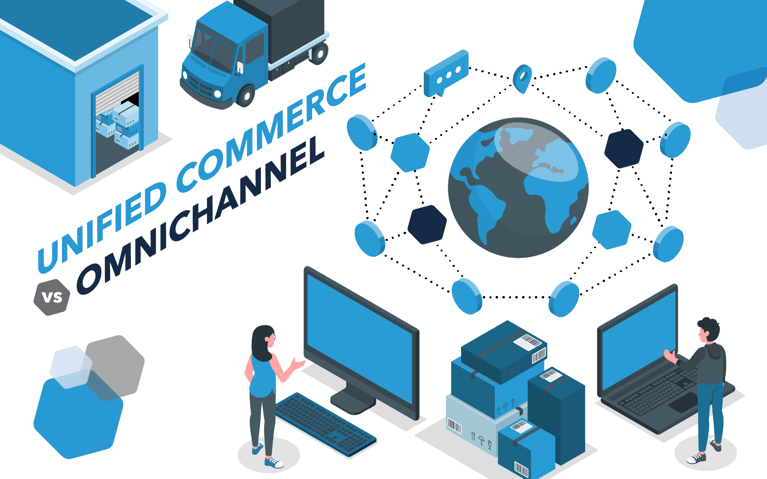This is an excerpt from Cart.com’s newest eBook “Scaling with unified commerce: A step-by-step guide,” an in-depth look at unified commerce, how it compares to other commerce strategies and how to implement a unified commerce strategy. Check out the full eBook here.
Part 2: The benefits of unified commerce and developing a strategy
Investment in the customer experience is essential for growth. Today’s customers seek an exceptional experience, with 61% saying they’ll pay 5% more to get one.3 When brands are able to consolidate customer data into a single source of truth – they have the beginnings of a highly effective strategy. However, they must ensure the data is accurate, timely and relevant to improving operations and the customer experience.
What are the benefits of unified commerce?
A unified commerce approach allows you to operate optimally in an omnichannel world. It allows retailers to better fulfill their promises by gaining a centralized, real-time platform for all customer touchpoints. Unified commerce helps brands effectively address key customer experience challenges, benefiting consumers and business alike.
Benefits to consumers
Unified commerce gives consumers a seamless and integrated shopping experience across various channels and touchpoints, providing numerous benefits that enhance convenience, satisfaction and overall shopping enjoyment. These benefits include:

- Eliminating barriers between online and offline shopping: Consumers can transition effortlessly between digital platforms and physical stores. This cohesive approach ensures consistency in product availability, pricing and promotions across all channels, enabling shoppers to browse, purchase and interact with brands in a way that best suits their preferences and needs.
- Providing better order fulfillment flexibility and convenience: Customers have multiple fulfillment options, including buy online, pick up in-store (BOPIS), curbside pickup and same-day delivery. This flexibility accommodates diverse consumer lifestyles and preferences, letting them to choose the most convenient method for receiving their purchases, whether they prefer immediate gratification or the convenience of online shopping.
- Elevating the personalization of the shopping experience: With unified commerce, brands can leverage comprehensive customer data and insights to deliver tailored, more targeted and relevant recommendations, promotions and content across all touchpoints. By understanding consumer preferences, purchase history and browsing behavior, brands can curate personalized shopping journeys that resonate with individual shoppers, increasing engagement and loyalty.
- Fostering transparency and trust: Customers gain real-time visibility into inventory availability, order status and delivery updates. This transparency builds confidence and reassures consumers that they can rely on the brand to fulfill their orders accurately and efficiently, thereby enhancing the overall shopping experience and reducing the likelihood of dissatisfaction or frustration.
Benefits to brands
Unified commerce offers retailers several advantages, transforming how they operate and interact with customers. Here are some key benefits:
- A holistic customer view: Unified commerce consolidates data from various channels into a single view, enabling retailers to gain a comprehensive understanding of their customers. This holistic view allows retailers to deliver personalized experiences tailored to individual preferences and behaviors.

- Improved operational efficiency: By integrating systems and processes across channels, unified commerce streamlines operations for retailers. This integration eliminates silos and redundancies, reducing complexity and improving efficiency in tasks such as inventory management, order fulfillment and customer service.
- Ability to create a seamless shopping experience: Unified commerce lets retailers offer a seamless customer journey and shopping experience across channels. Customers can research products online, make purchases in-store and access support through various touchpoints without encountering friction or inconsistencies in the process.
- Optimized inventory management: With real-time visibility into inventory levels across the entire supply chain, retailers can optimize their inventory management practices. They can maintain optimal stock levels, reduce overstock and stockouts and ensure that the right products are available at the right time and place to meet customer demand.
- Flexibility and scalability: Unified commerce provides retailers with the flexibility to adapt to changing market conditions and scale their operations as needed. Whether expanding into new markets, launching new sales channels or integrating emerging technologies, retailers can easily evolve their business strategies without disrupting existing operations.
- Enhanced customer loyalty: By delivering consistent and personalized experiences across channels, retailers can build stronger relationships with customers and foster loyalty. Customers with positive experiences are more likely to return for future purchases and recommend the brand to others, contributing to long-term success and growth.
Unified commerce empowers retailers to meet modern consumers' evolving needs and expectations while driving operational excellence and sustainable business growth. Businesses must learn how to develop and implement a unified commerce strategy to gain these benefits.
Getting started with unified commerce
Now that you understand what unified commerce is and isn't – and its benefits – it’s time to start developing a strategy to move toward a unified commerce model. Like anything, it requires planning and determining how and when to start. During the planning phase:
Determine data collection and analysis strategies
A unified commerce approach revolves around data, which becomes essential in setting and achieving goals. This makes it critical to begin with data collection and analysis to gain insights into customer behavior, market trends and operational performance. Here's is some of the data you’ll work with:
- Customer Data: Data related to customer interactions across all touchpoints, including online platforms, mobile apps, social media and physical stores. This data can include demographic information, purchase history, browsing behavior and feedback from customer interactions.
- Sales and inventory data: All transactions, inventory levels and product performance stats. It helps brands understand which products are popular, which ones are slow-moving and how inventory levels fluctuate over time. This information can help optimize inventory management and forecasting processes.

- Marketing and promotional data: Data from marketing campaigns, promotions and advertising efforts to assess their effectiveness in driving customer engagement, sales, and brand awareness. Understanding the ROI of marketing initiatives can inform future marketing strategies and investments.
- Operational data: Data from operational processes such as order fulfillment, shipping and customer service are used to identify areas for improvement and optimization. This data can highlight bottlenecks, inefficiencies and opportunities to enhance the customer experience.
- Technology and infrastructure data: Data that assess the performance and reliability of existing technology systems and infrastructure to ensure they can support the requirements of a unified commerce approach. Use to identify any gaps or limitations that must be addressed to enable seamless integration and data sharing across channels and within the centralized unified commerce platform.
Retailers can gain valuable insights into their current performance by starting with data and determining what to analyze and use. These insights serve as the foundation for setting strategic goals and objectives for implementing a unified commerce approach, ensuring alignment with business priorities and customer needs. Ongoing data monitoring and analysis are essential for measuring progress toward goals and making data-driven decisions to optimize the unified commerce strategy over time.
Set clear scaling goals
With an abundance of data at your disposal, there are a multitude of directions you could pursue. However, a strategic approach involves setting clear goals and prioritizing initiatives rather than attempting to tackle everything simultaneously. Begin by identifying objectives that demand minimal resources, allowing you to focus your efforts efficiently and make measurable progress toward your overarching goals. What actionable things can you do now? For example, could you partner with a 3PL that has a WMS (warehouse management system), OMS (order management system) and TMS (transportation management system) that already work together.
You can also do things like:
- Implement omnichannel inventory management: Sync inventory across all sales channels to gain accurate, real-time visibility and give customers access to product availability.
- Adopt a cloud-based POS system: Integrate your POS with your ecommerce platform for consistent and unified transactions across online and offline channels.
- Enhance website functionality: Incorporate responsive design, fast loading times and intuitive navigation as well as creating a seamless experience across devices.
- Integrate marketing channels: Deliver consistent messaging and promotions throughout email, social media and SMS, ensuring a consistent experience.
- Offer flexible fulfillment: Give multiple options, including BOPIS, same-day shipping and more.
By starting with easy or singular steps, businesses can lay the foundation for a unified commerce strategy and gradually expand their capabilities.
Select the right retail technology solutions

Selecting the right retail technology for a unified commerce approach starts with evaluating your current tech stack. Think of all the software you use throughout the customer journey and for operations. Consider anything that measures, tracks or provides insights. Ask yourself, does it provide the data you need now, and does it integrate? Some of the common solutions retail businesses use include:
- POS
- OMS/WMS
- CRM
- Inventory management
- Marketing automation
- Marketplace
- Chatbots
- Pixels
- Analytics
- Social
- Storefront
- And many more…
If you need software that better aligns with your goal and emerging strategy, take these steps to choose the right tech solutions for a unified commerce strategy:
By following these best practices, you can make informed decisions when selecting tech solutions for your unified commerce strategy and use solutions to drive operational efficiency, enhance customer experiences and achieve business growth.
- Step one: Assess current needs and future scalability. Evaluate your business requirements and growth projections to identify tech solutions that can scale with your business and accommodate evolving needs.
- Step two: Prioritize integration capabilities. Look for solutions that seamlessly integrate with existing systems, including POS, ERP, CRM and e-commerce platforms, to ensure data consistency and streamline operations.
- Step three: Focus on flexibility and customization. Opt for tech solutions that can be customized to align with your unique business processes and requirements, allowing for greater flexibility and adaptability to changing market conditions.
- Step four: Consider omnichannel capabilities: Choose tech solutions that support omnichannel functionalities, such as unified inventory management, order fulfillment and customer engagement, to deliver a consistent and cohesive shopping experience across all channels.
- Step five: Evaluate security and compliance features. To safeguard customer data and mitigate security risks, prioritize solutions that adhere to industry standards and compliance regulations, such as PCI DSS for payment processing and GDPR for data protection.
- Step six: Assess vendor reputation and support. Research vendors’ track records, customer reviews and support offerings to ensure reliability, responsiveness and ongoing assistance in implementing and maintaining the chosen tech solutions.
- Step seven: Plan for training and adoption. Develop a comprehensive training plan to educate employees to use new tech solutions and encourage adoption across the organization, fostering efficiency and maximizing ROI.
Stay flexible
Anyone who runs a business knows that it can take time for things to work, and sometimes, things don’t work out the way you expect. Because of changing factors, like consumer behaviors, the economy, cultural shifts and competition, solutions and strategies are not absolute. The key is resilience and adaptability: Being able to remain flexible, and pivot when necessary. As long as you stay focused on remaining unified, you’ll learn to implement and adjust as needed.
Want to learn more? Check out the rest of our eBook about unified commerce – along with strategies and best practices to implement and scale with a unified commerce approach.
Subscribe to our emails for the latest industry insights!
By entering your email, you agree to receive marketing emails from Cart.com







